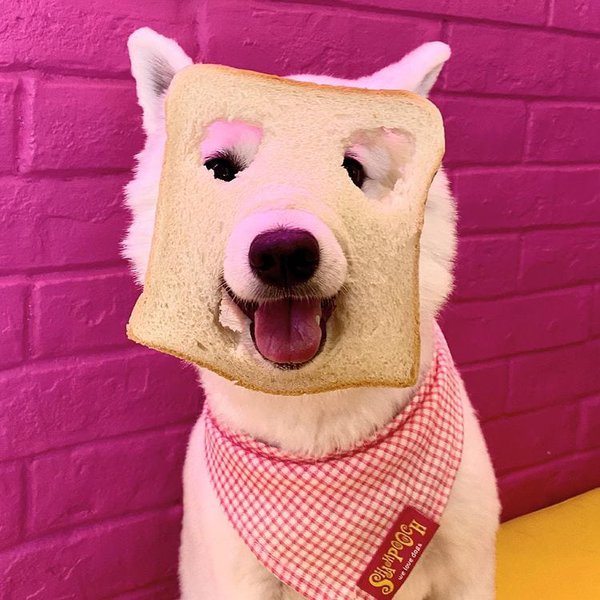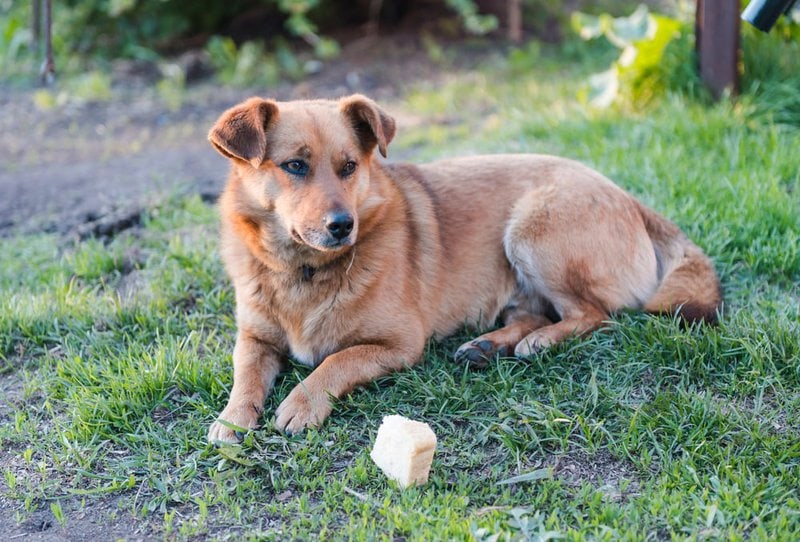Bread forms a large part of the human diet, with white bread being the most popular and accessible bread in the market. We also refer to it as sandwich bread or sandwich loaf.
It is no wonder then that we tend to share a bite or two sometimes with our furry babies every time we are having a snack or sandwich. But, is it safe and OK to feed it to our dogs?
Yes, dogs can eat white bread, but only in moderation. Feeding your pooch a large amount of white bread can lead to digestive distress. White bread does not also provide enough nutrients to merit as part of your dog’s regular meal.
However, as long as you feed your dogs their daily kibble and get enough exercise, additional treats like white bread are not necessary. In this article, we will discuss the nutritional “benefits” of white bread, its effects on the health of our furry babies, as well as the other alternatives to white bread that are available in the market.
Is It OK To Feed My Dog White Bread?

Yes, it is OK to feed your dog white bread but only in small quantities. It might experience some tummy upsets or mild bloating, though, if given in large amounts.
Bread should only be given as occasional treats since it is mostly composed of carbohydrates. Plus, the glucose content could spike the blood sugar levels of your dog.
Remember that the diet of your dog should consist of a balanced ratio of protein, carbohydrates, and fat which a portion of good dog food would amply provide.
What Is The Nutritional Value Of White Bread To Your Dog?
White bread is made from wheat flour with the germ and the bran removed from the grains during the milling process. This allows the bread to turn rancid easily and improves the shelf life of the bread.
This, however, removes the essential fatty acids, B-complex vitamins, iron, and most of the fibers, as well as, micronutrients like manganese, magnesium, and potassium. It is further bleached to remove any yellow-coloring left in the flour.
However, most of the white bread sold today is fortified with vitamins to make up for the nutrients lost during the milling process. Still, your fur baby won’t get any nutrients from eating white bread.
How Much White Bread Can A Dog Have?
Typically, an active dog should get around 20% of its diet from carbohydrates. As a rule of thumb, white bread or any bread should not exceed more than 5% of your dog’s daily meals.
White bread delivers calories through carbohydrates, and dogs are primarily carnivorous. They have a little nutritional requirement for carbs. Instead, protein and essential fats are their primary source of energy.
Since many quality dog foods are already well-balanced with protein, fats, and carbohydrates, any additional glucose from white bread is not necessary and beneficial.
A little treat here, and there is all the white bread your dog would ever need.
Is Feeding White Bread Bad To Your Dog Bad?

Yes, it’s because excess carbohydrates get stored in the body as fat.
And, since white bread is a high carbohydrate food, it can cause several problems for your dog over time if not carefully watched, such as the following:
Hyperglycemia
Some dogs, especially older ones that suffer from diabetes, could have hyperglycemia. Insulin, a hormone that regulates glucose, if not produced by the pancreas in adequate quantities, can abnormally spike their blood sugar levels.
Symptoms of hyperglycemia include increased thirst, increased urination, bloodshot eyes due to inflamed, red blood vessels, and excessive hunger.
Long-term effects include obesity or weight loss, liver enlargement, nerve damage, especially in the legs, prolonged infections, depression, and diabetes.
Tooth Decay
Bacteria easily attach to the sugar present in the mouth, especially the teeth and gums. As sugar accumulates in the enamel, tooth decay is not far behind which would eventually advance to periodontal diseases.
Gum disease causes uncomfortable pain and can lead to gum erosion and tooth loss. It is estimated that most dogs suffer from some kind of dental disease by the age of three.
Wheat Allergy
Some dogs suffer from wheat allergies. Common symptoms of wheat allergy include itchy, red skin, chronic ear infections, and discoloration of the feet from excessive licking.
Gluten Sensitivity
Gluten sensitivity or intolerance is due to the inability of the small intestines to digest gluten. Undigested gluten irritates the lining of the intestines causing it to absorb fewer nutrients from food.
Dogs who suffer from this condition have persistent diarrhea, weight loss, and lethargy. They eventually develop chronic fatigue, anemia, poor hair coat due to deficiencies in some nutrients, and neurological disorders.
Heart Disease
Excess glucose gets converted into fatty molecules that can accumulate in their blood vessels, developing plaque. This blocks too much pressure on the heart, causing heart disease.
Early signs include shortness of breath, lack of appetite, abdominal swelling due to fluid accumulating in the abdomen, and coughing.
Obesity
If you are spoiling your dog with too much white bread, it can lead to unwanted weight gain over time.
This affects their joints, making it difficult to move around. It also increases their risks for cancer, diabetes, hypertension, and heart disease.
What Should I Do If My Dog Ate Lots Of White Bread?
If by accident your dog treated itself to a loaf of bread lying around in the kitchen, there are some things you can do to check if your dog is starting to show signs of stomach distress.
Keep A Lid On It
The first thing to do, of course, is to keep the white bread away from your pooch. Store any loaves of bread or foods that can be toxic to them in a secure container and place it where he could not reach them.

Find Out How Much It Ate
Recall the quantity of white bread the last time you left it. Make a note of it in case your veterinarian asks.
Also, check if the bread has other ingredients that could be considered harmful to dogs, like raisins, chocolate, nuts, or xylitol.
Keep A Watchful Eye
Look for any warning signs that your dog may be in pain. Is it pacing restlessly or salivating profusely? Do you hear gurgling noises in its stomach, or is your pooch vomiting? Take note of all the symptoms to better monitor the situation.
Visit The Clinic
If your dog’s pain does not show signs of easing down, visit your veterinarian immediately. Your veterinarian may induce vomiting to stop further digestion of the bread.
Additional blood tests could also be necessary, especially if the bread came with ingredients that are considered toxic to dogs.
Are There Alternatives To White Bread I Can Feed My Dog?
Bread, in general, as was discussed above, should not be a regular part of your dog’s diet. Whole wheat bread, sourdough bread, baguettes, rye bread, or multigrain bread all have the same effect on your dogs because they are all mostly carbohydrates.
More fibrous bread, like whole-wheat bread or brown bread, however, can be used occasionally to aid in their digestion. The added fiber helps maintain a healthier digestive tract and also bulks up their stools if they are suffering from diarrhea.
Dog owners, on the other hand, should stay away from flavored bread like chocolate bread, raisin bread, garlic bread, and bread with nuts since the added ingredients are all toxic to dogs.
Loaves of bread that have artificial sweeteners, like xylitol, should also be avoided at all costs. Xylitol can poison your dog and cause vomiting, diarrhea, weakness, trembling, collapse, and seizures.






